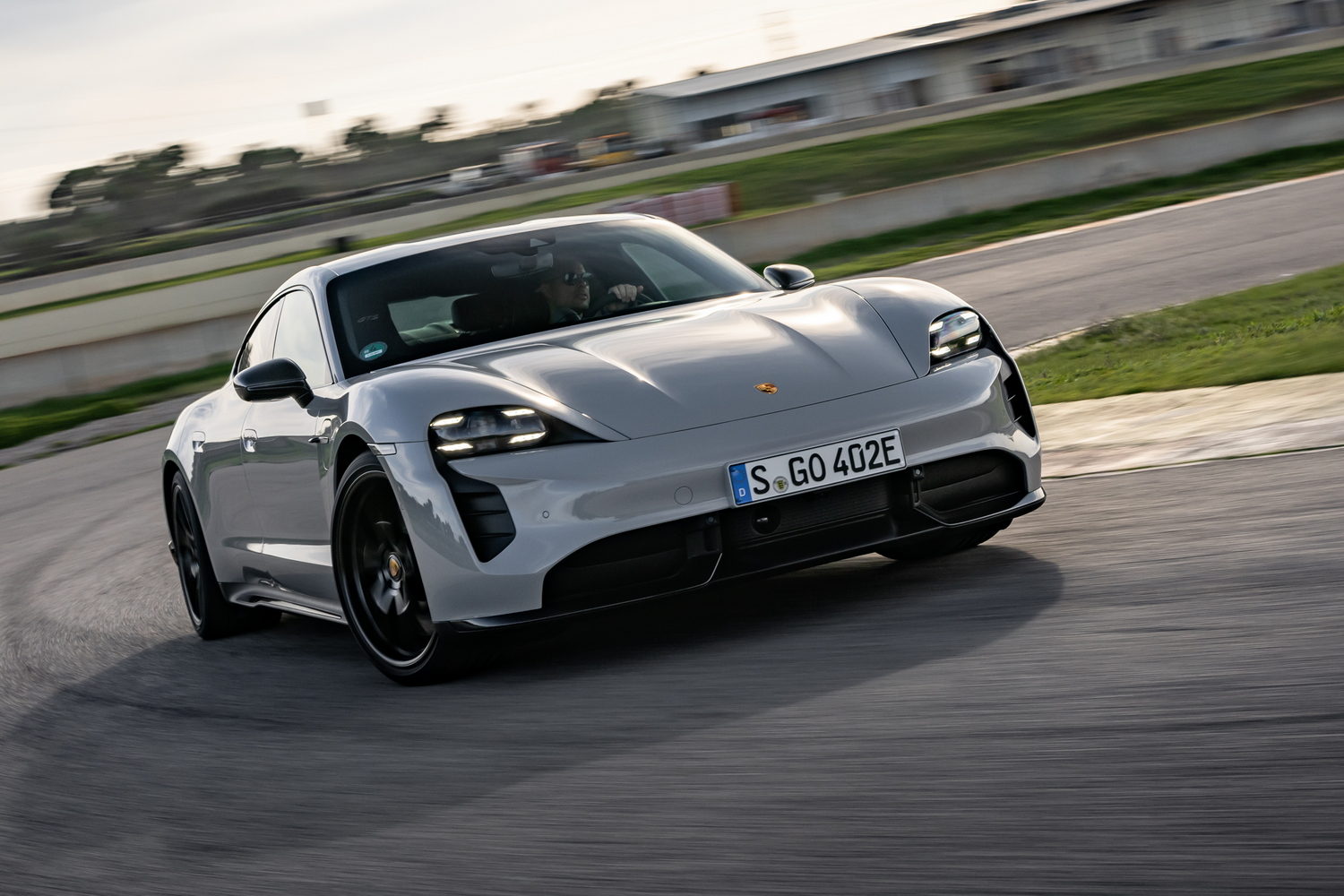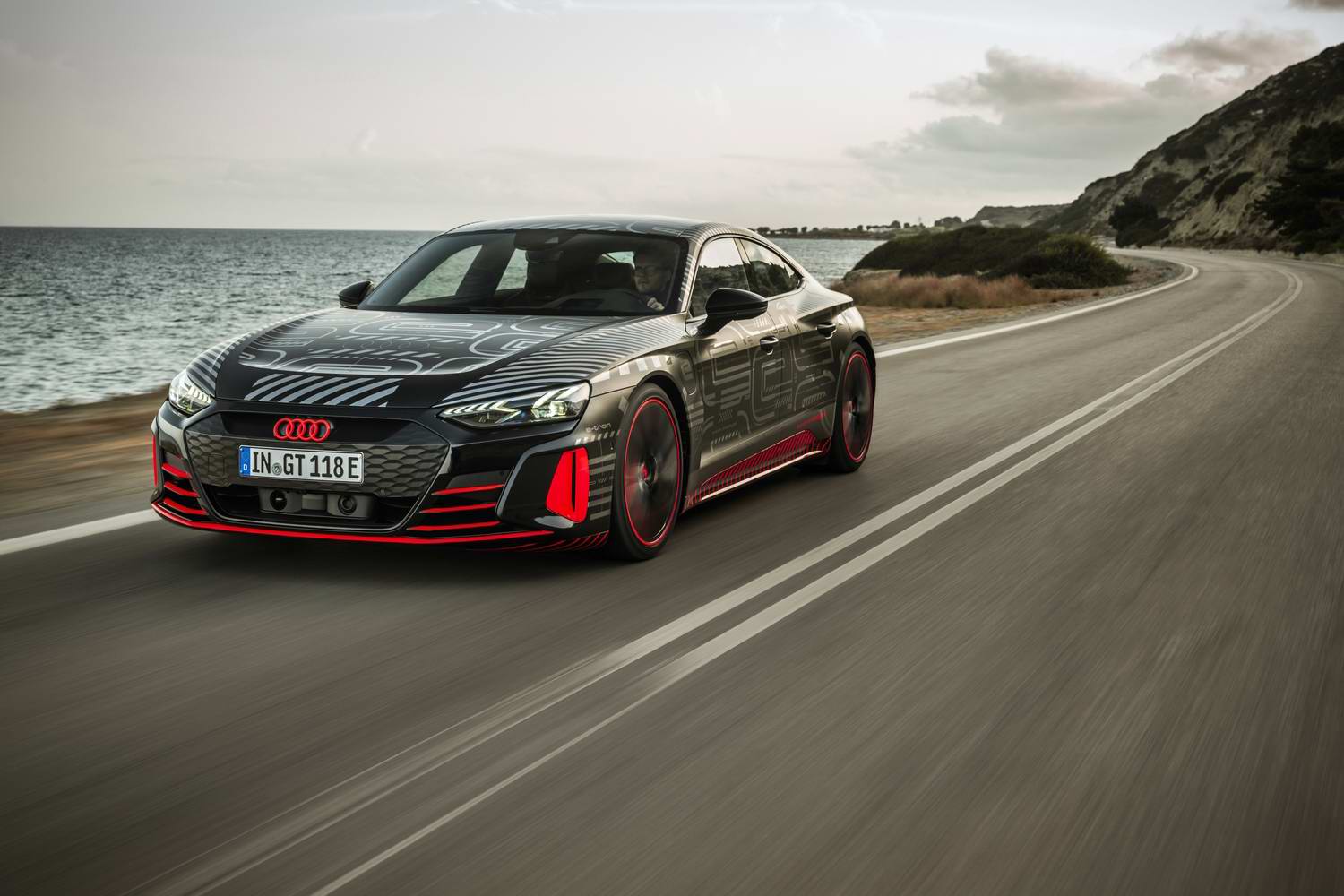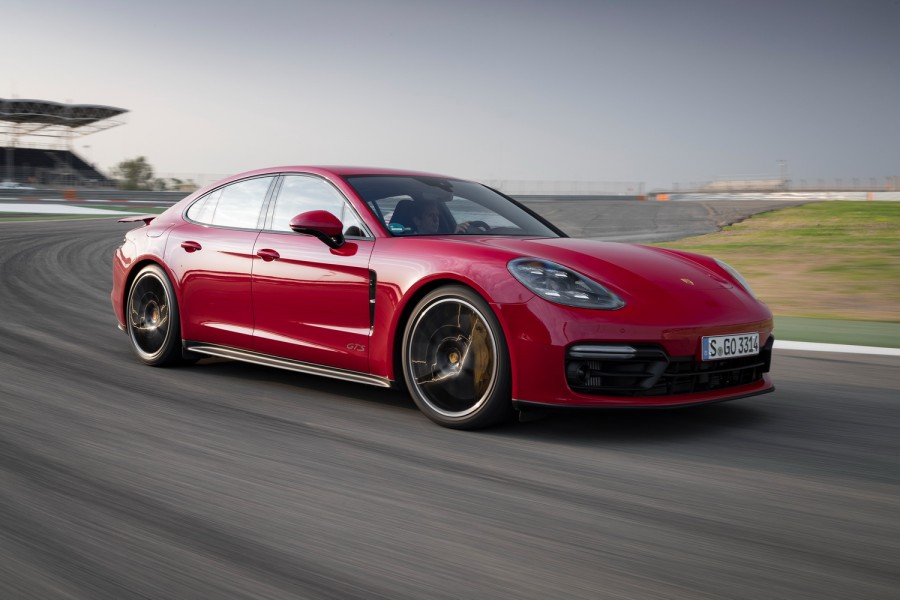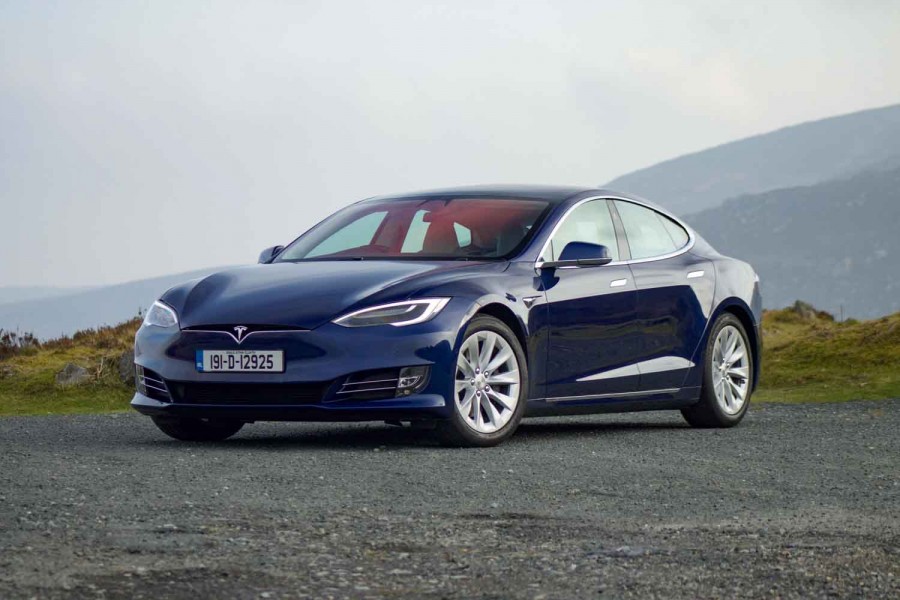The Porsche Taycan slotted straight in at the top of the electric sports saloon class when it was launched in 2020. Although handling and power set it apart from the rest, Porsche deemed the range-topping Turbo too much of a high-performance GT, and set about building an enthusiast's car that would be a "sporty sweet spot" between the 4S and the Turbo models. It's called the GTS, and we hit the track to find out just how sweet it is.
In the metal
The Taycan is among the sportiest-looking electric cars on the market, and the GTS version only strengthens those credentials. It has all the usual Taycan features, including the curvy headlights and the traditional Porsche proportions. But those crafty German designers have still managed to set the new boy apart, albeit using ideas taken from the 911 range.
That means the Taycan GTS comes with Porsche's Sport Design bumpers and black side skirts, just like every other GTS model in Porsche's range. Similarly, the standard LED headlights and daytime running lights are adorned with black trim, and there are 20-inch black alloys surrounding red brake callipers.
Inside, the GTS is primarily set apart by its Race-Tex upholstery - Porsche's microfibre, suede-style fabric inspired by race car interiors. But that makes it dark in there, thanks to black Race-Tex roof lining and brushed aluminium trim with a black anodised finish, not to mention the big, sculpted Sports Seats Plus with 18-way adjustment and memory settings for the driver and front passenger.
That darkness is intentional - a move designed to make the cabin feel more like a cockpit in what is, when all's said and done, the most driver-orientated model in the Taycan range. Customers can brighten things up slightly with the option of the GTS interior package, which provides Matt Carbon interior trim in place of the black-finished aluminium, and there's a choice of Carmine Red or Crayon contrast stitching.
The GTS also comes with the Sport Chrono package as standard, which means the heated, Race-Tex-clad steering wheel has a driving mode selection switch, offering a choice of Range, Normal, Sport, Sport Plus and Individual settings. These allow the driver to tune the experience to their preference, tweaking parameters including the standard-fit air suspension, response to the accelerator and the artificial sound that's designed to give the GTS its own, more focused character.
But in the main, the GTS feels very similar to the standard, base-spec Taycan. Not that we're complaining, because even the most basic Taycan is a shining example of Porsche's engineering prowess. There's no faulting the quality, with top-notch materials that have been brilliantly bolted together, and the ergonomics are generally good, too, even if the gear selector toggle feels a bit odd at first.
Sharing an interior with lowlier versions of the Taycan also means the cabin is as high-tech as the mechanical components. There's a big digital instrument display with customisable sections, a main central touchscreen and another in front of the passenger. There's also another display in the centre console, which has slightly odd-feeling haptic feedback, but allows the cabin to be almost entirely devoid of buttons.
Compared with some car makers, the button-free system works relatively well, but it isn't perfect. The centre console screen can be a little slow on the uptake and the two dashboard screens feel a little small and fiddly to be used on the move. But by and large, it's a solid, modern place to sit.
As long as you sit at the front, that is, where there's plenty of headroom and a great driving position. Enter through the rear doors and the legroom is fine, but air vents under the front seats limit space for those with bigger feet, while taller passengers will struggle for headroom. And the darkness that's just about manageable in the front feels slightly oppressive in the rear, with just the back of those sports seats to look at.
At least the luggage space is passable, with 407 litres at the back and an extra 84 litres of carrying capacity to be found under the bonnet. It's quite a shallow boot, which limits its use, but it's fine for suitcases and the like. And the back seats fold down if you really need the space. But if practicality matters that much, the forthcoming Sport Turismo estate model is the Taycan to choose.
Driving it
But in all likelihood, those who value practicality over performance will probably not pick this GTS version of the Taycan. Designed to be the most driver-centric version of Porsche's electric saloon (albeit not the most powerful), the GTS comes with specially tuned suspension, four-wheel drive and two electric motors, giving it a total of 517hp most of the time. That rises to 598hp with overboost, which means 0-100km/h takes just 3.7 seconds, and the top speed is a heady 250km/h. But outright speed is not the GTS's selling point. No, this is a car designed to give enthusiasts a thrill on a racetrack or an interesting back road.
Of course, all that performance helps. Having almost 600hp at the disposal of the driver's right foot means it's crushingly fast. The kick in the back is immense, forcing you back into your seat as the car is fired down the road. It's a gut-wrenching, slightly uncomfortable sensation, but it will make overtaking laughably simple and safe on the public road.
So there's a big tick in the performance box, but outright speed is the continent-crossing Taycan Turbo's domain. The GTS needs to meld that pace with a level of agility and tactility that simply isn't available elsewhere in the Taycan line-up. To that end, the chassis has been adapted to suit that character, giving it a slight sharpness that's missing from lesser models.
It builds on the high standard already set by the basic Taycans with a little more body control and a marginally stiffer ride, but the smooth surface of a racetrack didn't give us much indication of how tolerable that will be on Irish roads. We'll pass judgement on that when we get the GTS into a more representative environment.
However, the controlled conditions of a racetrack did allow us to explore the limits of the GTS's bountiful capability. Admittedly, our test car was fitted with the optional rear-axle steering system, which has also been specially tuned for the GTS, but the agility is simply astounding. The grip is relentless and the balance between front and rear is incredible. The car's substantial 2.3-tonne kerb weight doesn't go unnoticed, but most of the bulk is positioned so low in the car that it barely shifts on its springs as it's pitched into corners.
What the GTS misses is a little feedback through the steering wheel, but that's true elsewhere in the Taycan range, too. The steering can feel a little elastic around the straight-ahead position and at sensible speeds, but at higher speeds it feels as though it's in supreme control. There's no discernible delay between the wheel turning and the nose of the car following suit, while the rear axle really pulls that chunky rear end around the corner.
The brakes are similarly impressive, with our test car's optional ceramic composite discs offering mountainous stopping power that matches the face-bending quality of the acceleration. But while stopping such a heavy, fast-moving car in its tracks is impressive, there is still a slight sense of detachment. That said, the GTS's linear, progressive response to brake application puts it ahead of many electric and hybrid cars.
In short, we can pick holes if we try hard, but the GTS is unquestionably sublime. For a car that weighs this much, it's an incredibly satisfying car to drive quickly. The only real catch is the same is true of other Taycan models, so why should you pick the GTS?
In a bid to differentiate the GTS further from its stablemates, Porsche has tried to imbue the car with a little more soul by giving the newbie its own voice. The 'Porsche Electric Sport Sound' only really comes into play in Sport and Sport Plus modes, but it's designed to be louder and "richer" than in other Taycans - including the Turbo.
In truth, the noise is a bit odd. It's like a weirdly strangled, distant petrol engine with really bad supercharger whine, mixed with a little bit of Anakin Skywalker's pod racer. It's very obviously synthetic, but it still manages to add a little drama under acceleration and braking. Not least because it's tuned to make a kind of gear shift noise whenever the two-speed rear transmission swaps cogs.
On the road, it'll probably be better to opt for Normal mode, which is much more refined, or the GTS-specific Sport mode, which makes the car slightly quieter and marginally less responsive than in Sport Plus. And even though the GTS's Sport setting is designed to be more aggressive than in other Taycan models, toning down the Sport Plus savagery (both in terms of acceleration and suspension) will probably be welcome on the public road.
For all this sportiness, there's an electric car staple that we're yet to deal with: range. On paper, the GTS's 504km official range is among the biggest in the Taycan stable, which might appeal to customers who want to go further between charges. But as is so often the way, it isn't quite that simple. This discrepancy is down to an update that became available across the range earlier this year; it just doesn't figure in the official data for existing variants yet. Expect them to catch up when they go through the homologation process again.
And anyway, most customers probably won't achieve 504km in the real world, even in Range mode. It may be possible, but even if the climate control is switched off and other ancillaries powered down, around 300-350km is probably more achievable. Although having the willpower to avoid using that startling turn of pace will arguably be the biggest barrier to hypermiling.
What you get for your money
Porsche has not yet confirmed Irish pricing for the GTS, but we can reasonably expect it to sit somewhere between the €106,954 4S and the €148,752 Turbo. Of course, few customers will pay the starting price for their vehicle. Standard specification is hardly stingy, with three touchscreens, navigation, heated seats, parking sensors and two-zone climate control to name but a few, but we can't see many customers stopping there.
The bulging options list will lure people in, offering everything from rear-axle steering to a 360-degree parking camera and from ceramic brakes to carbon-fibre door sill scuff plates. You can even get the Track Precision smartphone app that gives you racing driver-style telemetry at a number of circuits around the world.
We haven't counted - there aren't enough hours in the day - but the individual options for paint, wheels and extra equipment must run into the hundreds. That means the chances of seeing two identical cars are slim, but the chances of seeing a completely standard GTS are almost non-existent.
Summary
Porsche claims the GTS is the sweet spot in the Taycan range, and for keen drivers there is definitely some truth in that. It's certainly among the most capable versions of the Taycan, and it's arguably the most soulful. But with every version of the Taycan providing pace aplenty and stunning handling, the extra expense is not easy to justify.
Despite Porsche's best efforts, the GTS just doesn't feel that much more engaging than its siblings - at least not at normal speeds. So unless you really love driving and you'll take your car on a few track days, the GTS probably isn't worth the outlay. But if that's exactly what you would buy a car to do, we've just found your perfect electric vehicle.


























